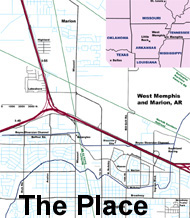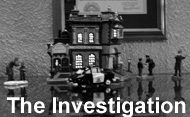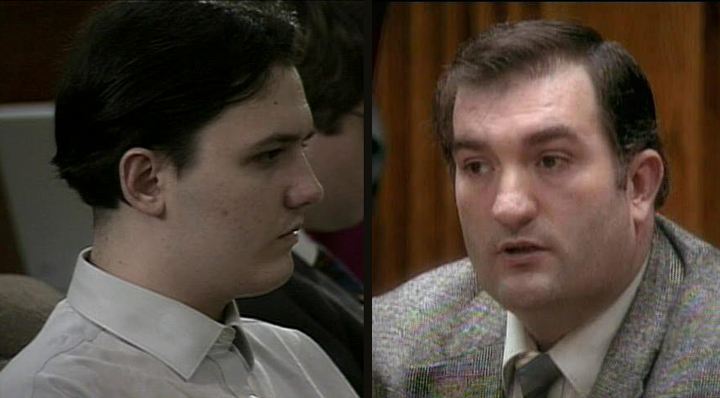Jivepuppi.com


Timeline of the
appearance of the evidence deemed significant by the jury in
determining the guilt of Damien Echols.
The wax evidence was never presented
to the defense.
Blue entries represent major events in the
case.
Green entries indicate when evidence was
uncovered or reports were dated, not when it was provided to the
defense.
A Twilight Kill, Part Nine: The Case Against Echols.
Perhaps Echols' personality and comportment
at trial
were as responsible as anything else for him being found guilty. Each
defendant displayed a different demeanor in the courtroom. Jessie
Misskelley was balled up with his head tucked down. Jason Baldwin
looked on wide-eyed as though his foot was snagged on a railway track
as an oncoming train approached. Damien Echols was sometimes mugging,
sometimes appearing to be in another world, detached from the concept
that his life was on the line. While Baldwin's list included only six
items, Echols' list had sixteen entries.
Nine of the items on the Jury's list as to factors
deciding Echols guilt were related to personality, behavior and his
testimony.
- Something to gain
- Dishonest
- Manipulative
- Wierd [sic]
- No credible
witness
- Inappropriate
thought patterns
- Lied during
testimony
- Travelled to
crime scene 200 times - 2 yrs. Lied.
- Blew kisses to
parents
Echols took the stand in his defense. From the jury
notes, it was a disaster for him. The jury concluded that he lied
regarding visiting the crime scene, that he lied during
his testimony and came to the general conclusion, "dishonest." Others
pertaining to his character included, "wierd," "manipulative" and the
cryptic "inappropriate thought patterns."
The prosecution cited how Echols presented himself
during his testimony. "And so it went through and he reeled off a
number of things and he kept
saying - just looking real flat, unemotional..." [Davis closing
arguments, Echols/Baldwin trial]
Echols blamed his medication.
Echols: I'm on
imipramine. It's for manic depression.
Davis: Does it have a
calming effect? Does it sedate you to some extent?
Echols: Makes you sleepy.
[Echols testimony, Echols/Baldwin trial]
One bit of outrageous behavior was cited by the
jurors: Echols blew kisses to the parents of the victims. Perhaps this
was in response to the threats they called his way.
The remainder of Echols list.
- Incriminating testimony - Ridge
- too close to facts
- Satanic follower - Anton Lavae
[sic] - Alesister Crowley [sic]
- "Eat father alive"
- Carried knives
- Wax on book, shirt
- Fiber match
- Secondary confession
- ballfield girls
Echols Versus Ridge
As to what was considered most important
in
determining the convictions, the jurors ranked the witnesses.
Taking spots 1 and 3, were Detective Mike Allen and Medical Examiner
Frank Peretti. These presented evidence describing the crime, not
pointing to who was guilty. Taking second place was Bryn Ridge.
Ridge interviewed Echols on May 10th, the Monday
after the murders. Although Echols was at the police station all of the
afternoon and into the early evening, no recording was made of their
exchanges. Ridge had to rely on his summary notes.
Ridge was concerned that Echols knew too many
details consistent with the crime. When Echols was asked how the
victims died, according to Ridge he said, "that they probably died of
mutilation, some guy had cut up, cut the bodies up. Heard that
they were in the water, they may have drowned. He said at least
one was more cut up than the others." [Ridge testimony,
Echols/Baldwin trial]
The prosecution exaggerated the specificity. "And
then he tells Detective Ridge, when Detective Ridge asked him, "How do
you think they died?" -- "Mutilation. Two of them probably
drowned. One of them was cut up more than the others."
Coincidence? He just guessed? Did the police even know that two drowned
at that point? [Fogleman closing argument, Echols/Baldwin trial]
When Echols took the stand, he denied even having
said what Ridge had in his notes.
Prosecutor Davis: You
indicated that you heard they were drowned?
Echols: No. I indicated I
heard they were mutilated.
Davis: So when he put
down
in his response to that question, "Heard that they drowned," he [Ridge]
made
that up, too? That just isn't true?
Echols: They made up a
lot of stuff so far... [Echols testimony, Echols/Baldwin trial]
Echols defined the battleground. He accused the
police of lying. The jury
would have to choose one or the other as telling the truth.
The defense tried to demonstrate what Echols said
was common knowledge.
Val Price: Do you recall
the Commercial Appeal newspaper
article on May the 7th, 1993. Read the headline right there,
please.
Echols: "Mutilated Bodies
of Three Boys Found in Bayou." [ibid]
Beyond specific knowledge, Ridge portrayed Echols as
having a sinister character. Ridge recalled a seemingly malevolent
response by Echols regarding his view of evil.
Fogleman: What did he say about
uh doing evil, about how that would return?
Ridge: Doing evil would be returned three times, in other words,
that
the evil done would be returned in revenge three times back to the
doer. [Ridge testimony, Echols/Baldwin trial]
Echols' attorney brought up that Lieutenant Sudbury,
also present during the interview, had written more benign notes.
Price:
(Reading from questionnaire) Have you ever wondered what it would be
like to kill someone even if you didn't go through with it? I
believe the answer is on 19: Only out of anger to beat someone up.
Whatever you do comes back to you three times, so does good.
Ridge: I don't remember
that portion. [ibid]
The
battle of testimonies between Damien Echols (left) and Detective Ridge
(right) became a key factor in determining guilt.
Satanic follower
The jurors made the note under Echols,
"Satanic
follower" connected by dashes to "Anton Lavae" and "Alesister Crowley"
(correctly Anton LaVey and Aleister Crowley).
According to Ridge, he asked Echols who his favorite
authors were. Ridge said Echols answered, "Anton LaVey, Satanist book
and likes Stephen King novels because they are scary." [Detective Ridge
testimony, Echols/Baldwin trial]
Echols denied ever having read Anton LaVey.
Davis: Who told him
Stephen King was one of your favorite authors?
Echols: He asked me did I
like him. I said, yes, I did.
Davis: Did he ask you
about Anton LaVey?
Echols: Yes, he did.
Davis: And what did you
tell him?
Echols: I said I haven't
read anything by him, but I am familiar with him. [Echols testimony,
Echols/Baldwin trial]
Echols was presented with some scrawlings on a
paper. It included a coded alphabet. Parts of the code were translated
including Echols' name and the names of his newborn son, Jason Baldwin
and Aleister Crowley. The prosecution pounded Echols about Crowley and
Satanism.
Davis: Had you studied
Aleister's book pretty carefully?
Echols: Never any book by
him in particular. I have never saw any of his. [ibid]
Echols admitted a potential interest in Crowley, but
repeated he never read anything by him. After Echols said he had
written down the code out of boredom the prosecution asked:
Davis: Do you do any
satanic incantations out there while you are bored?
Echols: No, I do not. [ibid]
When the defense realized the source of the document
they strongly objected. They had been caught off-guard and were
astounded - and livid. They had never seen the document before,
were concerned about the fact it was illegally obtained from Echols
prison cell, about the chain of custody and the fact it was a
photocopy. If they had seen it before, perhaps they would have noted
the English writing (the translation of the code) was not written by
Echols. The opening line had been mistranslated. It did not read
"Damien ----- Echols." It read "Damien loves Domini."
Burnett ruled that, since the evidence had not been
made available to the defense, the document would not be made available
to the jury - however, Echols testimony regarding it stood.
This was the only connection made between Echols and
Crowley beyond the prosecution repeated assertions and the speculations
of Dale Griffis.
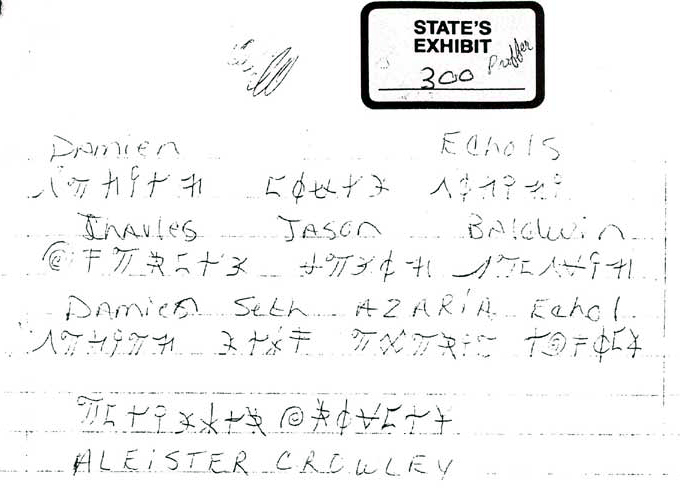
The state presented this as evidence of
Echols' interest in Crowley.
The first line correctly translates as
"Damien loves Domini."
Also suggestive of malevolence was the
statement
Echols admitted to have made during an argument he had with his father:
"I'll eat you
alive." This statement was presented by
Jerry Driver in his December 1993 interview. As Driver was Echols
probation officer and Echols was a juvenile at the time, it was of
questionable admissibility.
Carried knives
Although the knife found in the lake was
cited as
evidence against Baldwin, it was not on the jury's list against
Echols. The jurors did mention "carried knives." This was related to
testimony from his ex-girlfriend Deanna Holcomb. Her statement to
police about Damien carrying a knife was not made until two weeks
before the trials.
The defense asked about the late arrival of her
statement.
Holcomb: It was um - a week or
two ago.
Davidson: A week or two ago,
would - would it have been February the 14th? Does that sound right -
Valentine's day?
Holcomb: Yes sir. [Holcomb
testimony, Echols/Baldwin trial]
Wax on book, shirt
There were two pieces of physical evidence
cited by
the jury: the fibers (previously discussed) and "wax on book, shirt."
According to the state crime lab expert, Lisa
Sakevicius, "On the item, my E-2 item, which was a [victim's] shirt, I
did find a blue wax." [Sakevicius testimony, Echols/Baldwin trial]
Among items seized from Echols trailer during the
execution of the search warrant was a book with some candle wax, the
title, "Never on a Broomstick."
Out of the presence of the jury, the defense asked
why they hadn't received any reports about wax.
Scott
Davidson: Your Honor, we'd also request a copy of the
report of
Lisa Sakevicius - if there is one - regarding any candle wax.
Fogleman: I don't know if
there is one. She said that what she puts in her report is when
there are matches. She claimed that didn't match anything. [Bench
conference, Echols/Baldwin trial]
In his closing statement, the prosecution argued the
wax's presence was a sign of Satanic ritual. Furthermore, even though
the prosecution had previously stated that Sakevicius had declared the
waxes did not match and that was why the defense was not provided with
a report, the prosecution argued the waxes from the shirt and book
could be matches.
Remember
this book that just comes from the library? See all this stain
on the back of it? You all go back there and look a that and kindly
tilt it in the light and look and it, and see if that isn't blue wax to
you. See if that doesn't look like some blue wax to you. [snip] Well,
we got one of the boys' shirts that had that blue wax on his shirt. . .
[Davis, closing arguments, Echols/Baldwin trial]
Rumors and confessions
It all went wrong from the time of the
discovery of
the cub scout cap. Jones and Sudbury with their speculations of the
occult killings planted the seeds of wild rumors. These rumors found
particularly fertile soil among the area youth.
Like urban legends, the harder the source of the
rumors was pursued, the more illusory the claim became. In one
instance,
Loretta Smith, a fourth grade student in a nearby town, told police
that Michelle Elinburg had said that her brother, "Damien Elinburg" was
the murderer. A music teacher from the same school reported that four
or five of her students said that the murderer was someone named Damien
who was a "satist or a devil person."
Officer Bill Durham of the West Memphis police
headed to the town to investigate. Three people including the chief of
police, identified a photo of Damien Echols as the one they knew as
Michael Elinburg. Michelle Elinburg was brought in. She provided a
written statement saying that she had never told any such story to
Loretta Smith. Loretta Smith, in turn, wrote: "It was all a lie and I'm
sorry
that I said it ok I promise to god that I will not say it again. I will
never say it again and Michelle did not say what I told you I was the
one who made that up and she did not tell me anything." The police also
ran down Michael Elinburg who was
certainly not the same person as Damien Echols.
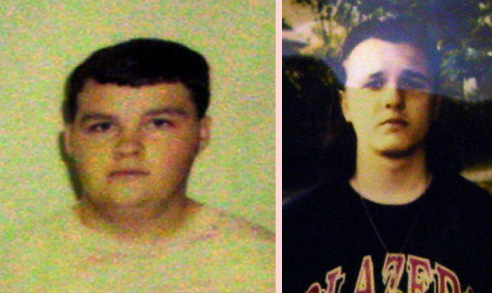
Three
persons, including the chief of police and another officer identified
Michael Elinburg (left) as being the same person as Damien Echols (right).
The Skating Rink Girls
Several youngsters came forward saying they
overheard Echols confess at the local skating rink. Jennifer Ball said
she had heard that Damien Echols was going to kill two more virgins.
She also described an encounter at the skating rink in which Damien
followed her with his eyes. Then,
While
we were walking out of the blue Amanda [Lancaster] started saying
shut up shut up. I looked at her & asked her wat was wrong.
She said that she could hear Damien in her mind saying "Bitch you're
gonna die, you know to much." (Last year Amanda had P.E.
w/Damien. She said he would sit there & enter her mind. It really
freaked her out.) [Jennifer Ball statement, June 10, 1993, for each
statement, spelling is as in the original.]
Amanda went on to say "Jennifer Harrison had said
that she thought Damean had done it cause he new way to much, and he
went around Horseshoe the same day the murders had happened, and had
dog intestents around his neck." [Amanda Lancaster statement, June 10,
1993]
Joni Brown, aged 14, said she was at the skating
rink on Friday, May 14th, 1993. She said her friend Whitney Nix
told her she overheard a Robert Burch say he and Damien Echols murdered
the three victims and were going to kill two more. Brown also said Toni
Cissell had overheard Damien confess. In turn, fifteen-year-old Toni
Cissell stated she had heard this story from Jennifer Ashley and
Crystal Hensley.
Whitney Nix, 12 years old, stated she had heard this
from a friend Nicol Bumbaugh. And here the story ends, for now,
inasmuch as Ashley, Bumbaugh and Hensley interviews are unavailable to
follow this to its ultimate source. Nix went on to relate this story
about Echols.
My
friend Natalie told me that he went to her Church one night and it
was a lord super and he droped the brade and he would not drinke the o
jushe. [Nix statement, June 15, 1993]
The Softball Girls
Two young children who professed to hear
Echols
confess were to testify at trial. They became known as the "softball
girls." Following the leads from child to child to determine who
overheard what spun the police in dizzy circles.
Shortly after the arrests, the police received
information that a Jenni Deacon, aged 13, had overheard Echols
say he killed the children. When interviewed, Jenni Deacon stated she
had been at J.W. Rich Girls Club softball field on the first of June
but that it was her friend Rachael Myers who had told her that she
(Myers) had overheard the confession. In turn, Rachel Myers had
said a Shelly Wolfe had
overheard Damien confess while at a softball park. Ridge interviewed
Wolfe who said she had heard this from Shannon Boals.
Shannon Boals, aged fourteen, described it a bit
differently.
Around
May 21, 93 [6:30 or 7:00 written above line] I was at the Girls
Club in West Memphis at my softball game and this girl name Michelle
Carter told me that Damien Echols came up to her and said that he
killed those boys and I just said really and she said yes.
[Shannon Boals, September 7, 1993]
Returning the favor, Michelle Carter (age unknown)
said she was told by Shannon Boals. "About 2 weeks ago at my
ballgame at the Girls Club I was told by Shannon Boals from Marion that
there was a boy named Damien that said he killed the boys and he didn't
cut their thing off he bite it off." [Michelle Carter interview,
June 9,
1993]
Trey Boals [15 y.o.], Shannon's brother, said he and
David Smith heard a David Way state he had overheard Echols
confess. David Way [18 y.o.] said he heard this from David Smith.
There are no notes regarding David Smith's version.
While conducting the interview with Shelley
Wolfe, Detective Ridge encountered Katie LaFoy.
Thirteen-year-old
Katie LaFoy said she was present at the softball
field at the Girl's Club (on Shoppingway, near Balfour) on the first of
June, when Damien spoke to a group of girls including a "Jody Medford."
Although Katie said she missed the beginning of the conversation, she
did hear Damien say, "yea that I’m going to do it to some more
people too." She said she had heard enough to know he was referring to
the homicide. Damien then went on to threaten them so they would not
talk. Katie said Jason Baldwin was there. [Ridge notes, LaFoy
interview]
In a June 7th statement, 14 year-old Jodee Medford
said during the week
of May 24th, she had overheard Damien Echols talking to a group of five
or six people at the Girl's Club. She did not recognize the people, but
Jason Baldwin was not among them. She said she heard Damien say "that
he had killed the 3 little boys and that before he turned himself in -
he was going to kill 2 more and that he already had one picked out."
She said Jackie Medford and Christy Van Vickle were with her. In a June
11th statement she changed this, saying Damien had said this to a group
including Jason Baldwin.
Her sister, ten-year-old Jackie Medford, confirmed
part of the story, saying she was there with her best friend Christy
and her sister Jodee when she heard Echols say he killed the three
little boys. She did not recognize any of the people to whom
Echols was talking.
Although not mentioned as being there in her
sisters' or mother's statements, twelve-year-old Jessica Medford said
she was sitting with her mother when her cousin, Katie Hendrix asked
Echols a question and Jessica overheard Echols answer he killed the
three boys.
Donna Medford, the mother of the Medford girls, said
she drove a carload of the children home after the ball game including
her daughters Jodee and Jackie, Christy Van Vickle and Katie Hendrix.
Noticeably absent from her account was Jessica Medford. "They all
started talking at once telling me about what the wierd black haired
boy had said that night. The all said they heard him say that he had
killed those 3 little boys." [Donna Medford, June 7, 1993] According to
Donna, Katie Hendrix went on to say "... he had said he was going to
bite her titties off. When he left she yelled 'Did you really kill
those 3 boys & he yelled 'yes'." [ibid] Donna Medford said she did
not overhear Echols say anything, but she did see him there that night.
Katie Hendrix does not have an interview folder.
Eleven-year-old Christy VanVickle in a June 11th
statement said two weeks ago she was with Jackee Medford at Girls Club.
She said she saw Damien Echols and Jason Baldwin talking to a lot of
people. "I heard him say that he killed the three boys. It scared me so
I walked away. I didn't hear him say any thing else." [Christy
VanVickle, June 11, 1993]
The statements of Christy VanVickle and Jodee
Medford were each one short paragraph. They were called as
witnesses. The gist of Jodee Medford's testimony was: "I heard
Damien Echols say that he killed the
three little boys and before he turned himself in, that he was gonna
kill 2 more and he already had one of 'em picked out." [Jodee
Medford testimony, Echols/Baldwin trial]
Jodee Medford went on to elaborate her account. At
about 6:30 pm
she walked around the corner of a concession stand and saw Damien
Echols about 25 feet away. Echols was talking to a group of six
or seven people. Jason Baldwin was nearby and his girlfriend, Heather,
was standing next to him. In contrast to her June 7th statement, she
testified Jackee and Christy were not with her.
Prosecutor Fogleman: Ok. And uh
- where - were you with your sister Jackie at that time?
Medford: No sir. [snip]
...cross examination, Echols attorney, Scott Davidson.
Davidson: Ok. Did - when you say you heard this conversation,
did you see, uh - Christy?
Medford: Uh uh.
Davidson: She wasn't around?
Medford: No sir. [ibid]
Jodee didn't inform the police or authorities for
two weeks. Jodee testified she had never seen Echols before and did not
know who he was until after the arrests when she saw him on television.
Christy VanVickle did not add much to her statement
during testimony. She said she was with Jackie Medford when she
overheard Echols confess.
Davidson: Ok. And were - who
were you with at the ballpark?
VanVickle: Um - Jackie Medford.
Davidson: Jackie Medford?
VanVickle: Um hmm.
Davidson: And anybody else?
VanVickle: No sir. [VanVickle testimony,
Echols/Baldwin trial]
In contrast, Jackie Medford had stated Jodee Medford
was with them and in her testimony Jodee Medford had stated she was
alone. VanVickle did not quote Echols words, just that "I heard, um -
Damien Echols say that he killed the three boys." [ibid] Christy could
not provide any details about the context or tone of the confession.
Among the twelve instances when she answered she didn't know or
couldn't remember:
Davidson: Did - what did he say
before you say that he said he killed those three boys, what did he say
before that?
VanVickle: I don't know.
Davidson: What did he say after
that?
VanVickle: I don't know.
Davidson: And how close were
you to him?
VanVickle: I wasn't close.
Davidson: You weren't close.
Did he scream it?
VanVickle: I don't know.
[ibid]
Like all of the softball girls, Christy VanVickle
only came forward after the arrests.
Jury's ranking of witnesses, 1 through 10.
- Mike Allen,
assisted in discovery of victims
- Bryn Ridge,
present throughout investigation
- Frank Peretti,
medical examiner
- Michael Carson,
jailhouse informant
- The Hollingsworths
- Lisa Sakevicius,
fiber and trace evidence specialist
- Deanna Holcomb -
Echols carried knives.
- Dale Griffis,
occult expert
- VanVickle,
softball girl
- Medford, softball
girl
Along
with
declarations of witches' numbers and the implied malevolence of
black shirts, the accusations of young girls helped transform this
case
into a Salem-like witch trial. Among items entered into evidence
was a library book checked out by Echols and written by Cotton Mather,
one of the Puritan chroniclers of Salem.
There were many rumors of confessions, without
exception they came from children and teenagers. In the case of
the
softball girls, there were several witnesses who gave contradictory
stories that Echols had confessed at the Girl's Club on multiple nights
under multiple circumstances, in front of a crowd or not, with Jason
present or not, with Damien either making a short declaration or else
answering questions. The names of the girl's friends who were
with them at the time also changed between accounts. From the
many claims of casually overheard confessions at the softball park and
at the skating rink, two made it to trial. Two children, one aged
fourteen, one eleven, took the stand to accuse Damien Echols.
Echols was found guilty. He was given three death
sentences. He is currently on death row.
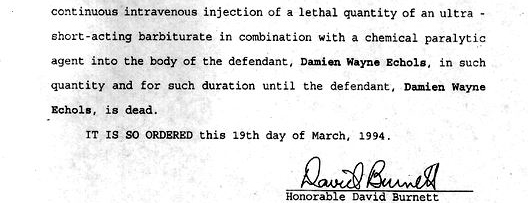
Damien
Echols, order of execution.




